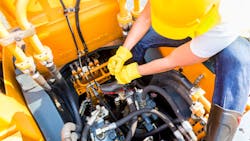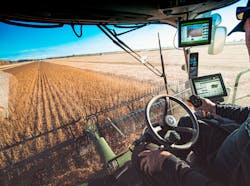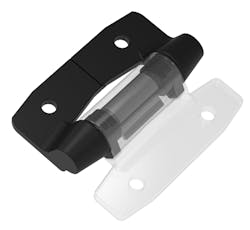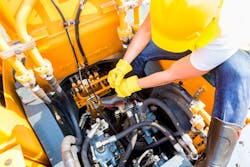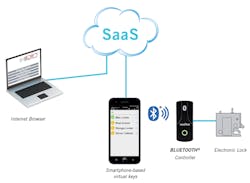Refining the 21st Century Off-Highway Truck Cab
Engineers are busy trying to automate some of the tasks the operators of off-highway vehicles perform, such as digging trenches and spraying agricultural fields with herbicides. At the same time, they are striving to improve the efficiency and performance of those vehicles, as well as their overall safety. Whether or not off-highway equipment (OHE) eventually becomes fully autonomous and “eliminates the cab,” however, remains an open question.
OHE today can be programmed to perform certain functions, including the aforementioned trench digging and spraying herbicides, but many of those tasks still need an operator to be in the driver seat to move the vehicle from point to point and supervise the machine’s work. In some cases, if the operator has nothing to do with a certain task, he or she may focus on other tasks such as responding to email or doing some bookwork.
This means the cab will be more like mobile work offices where operators may have other responsibilities, such as work site supervision they can perform while keeping an eye on the equipment and the job being completed. With an operator no longer needed to control all the equipment’s functions, they can instead use in-cab equipment such as computers to do planning, communicate with other work crews and complete tasks that can’t be automated. Here’s a quick look at what future cabs may look like.
Safety and Visibility
Improved vision and proximity sensors should increase safety and visibility in autonomous equipment regardless of where they are operating.
With driver visibility, designers maximize the glass in the cab and add mirrors to let the driver see all round to maneuver it safely. With the change to self-driving vehicles, engineers are adding vision cameras and sensors to help drivers understand what's going on around the machinery.
A large mirror mounted on the door lets the driver see behind the vehicle, but it also obstructs the driver’s vision. To eliminate this obstruction, engineers are mounting a small camera on the side of the mirror or on the door. It gives the driver a much broader view of the surrounding area. This puts the truck one step closer to being a self-driving vehicle because the sensors and cameras will be able to collect the necessary data for autonomous operation. In addition, the sensors can be tied into the vehicle monitoring subsystem to improve security.
Security Challenges and Electronic Access
As technological advancements add to safety and efficient operation, they also increase the cost of the equipment in and on the vehicle, as well as the temptation for theft and vandalism. Providing electronic access can elevate both the security and control of off-highway equipment. As off-highway equipment becomes more autonomous and incorporates more sophisticated technology, it’s easier to include electronic access latches.
Just as consumers are purchasing video doorbells with motion sensors that can video monitor their front doors from their smartphones, electronic access technology can supply a similar level of protection and tracking. Major component suppliers now offer devices that combine Bluetooth technology with electronic locks to simplify access and key management. These set ups let an operator’s smart device, typically a smartphone, act as a “key.”
Time-based virtual keys can be sent wirelessly to a smartphone application via a cloud-based web portal, simplifying the task assigning keys to several users. Operation is intuitive, as the operator or site manager simply opens the app to see their virtual keys, along with the associated locked equipment location, description and period of access time. This simplifies operations at the equipment yard or work site. Without electronic access, stored equipment needs an attendant to handle recording assignments and handing over keys. If a piece of equipment is on-site for several days, someone from the construction crew must collect and distribute keys daily.
One of the most important advantages of electronic access is the real-time aspect of the information it collects. Electronic-access devices can identify who is using what equipment and where, in real or near-real time. This data can be added into other data streams to aid in planning, cost analysis and other management areas.
Ultimately, more efficient security affects the bottom line for equipment owners, rental companies and end-users. Preventing theft and vandalism reduces repair costs and insurance headaches. More importantly, it reduces machine downtime and increases availability, which improves profitability by ensuring projects are completed on time.
Operator Comfort
Applying advanced technology to operator ergonomics and equipment access helps ensure off-highway equipment is safer and more productive. Incorporating the latest positioning and latching technologies both within the operator cab and on other access points in the vehicle improves the end-user experience by delivering maximum performance and efficiency at every job site.
Ergonomics within the cab are changing. For example, the number of screens inside the cab let operators know what is going on around the equipment and with the equipment itself. Many vehicles have different operators working in them from day to day. So just like seat and steering wheels, the screens need to be periodically repositioned or angled.
Position control products, such as torque hinges and display arms, can adjust screens to operator preferences to prevent strain, alleviate glare and provide maximize operator visibility. For instance, constant-torque hinges let operators adjust screen position and angle with one hand and the screen will remain in place regardless of vibrations from operating in rough off-highway environments.
The same constant-torque hinges can also keep smartphones and tablets in the right place for operators to use them without stretching or taking their eyes of the road or operating equipment. Many operators now use both devices (phones and tablets) as daily work tools, so furnishings that use such access hardware should be available.
Outside of the cab, there are tool cabinets, engine covers and other equipment that must be tightly secured yet easily accessible. The ability to easily and intuitively open and close heavy equipment panels often depend on the hinges used.
It’s common for heavy hoods to use gas struts to help raise and hold them in place. However, there is a range of position control hinges, including torque hinges and counterbalances subsystems that make it easier and safer to lift heavy hoods and hold them in place while retrieving tools or performing maintenance.
One area that has been a major focus for improvements is operator cab air quality. Off-highway OEMs have been upgrading the heating, ventilating and air conditioning in the vehicles. This includes sealing cabs better to eliminate air leaks and keep dust out.
To do this, designers use stronger, heavy-duty compression latches to close doors and windows, as well as access latches that secure doors covering air filters. Filter access panels must be tightly secured yet easily accessible, because the filters can be changed often.
As off-highway vehicles and equipment incorporate autonomous operating technologies, OEMs and end-users will want to be assured that investments are also being made to introduce advances in safety, security and operation.
High-tech hardware such as electronic access latches and intuitive positioners contribute to these improvement efforts. They give off-highway equipment designers ways to equipment productivity, as well as protect it from vandalism, theft, damage and accidents.
Bob Straka is general manager of the Transportation Div. at Southco, Inc.
